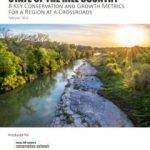“Protect our groundwater rights and Texas aquifers.”
That was the rallying cry for a group of landowners at a key Texas Senate committee meeting last November on the potential danger of a massive Central Texas groundwater export project.
The landowners depend on groundwater from the Carrizo Wilcox Aquifer, which encompasses the Carrizo and underlying Simsboro aquifers. The Vista Ridge Pipeline project pumps 16 billion gallons per year out of the aquifer in rural Burleson County and sends it 142 miles southwest to San Antonio.
Landowners and local officials testified that Vista Ridge’s pumping is endangering these communities’ only sources of water. “Some landowners have experienced up to 150 feet of drawdown in the Carrizo Aquifer, and there are wells that are experiencing two feet of water loss each month,” said Andy Wier, Executive Director of the Simsboro Aquifer Water Defense Fund. “Domestic and livestock wells are our rural water infrastructure.”
Thirsty cities, industries, and groundwater developers have long thought of the Carrizo Wilcox Aquifer as a limitless supply of fresh groundwater — one that could be pumped and piped across the state to meet increasing water demands. But over pumping and climate change-fueled droughts are exposing the aquifer’s limits.
Geological features of the Carrizo-Wilcox Aquifer — referred to as a confined aquifer — compound the problem. In confined aquifers, underground rock layers keep water under pressure, causing water levels to rise inside a well.
Large-scale groundwater pumping, by projects such as Vista Ridge, can trigger significant changes in water pressure, causing water levels to drop and making it harder — and much more expensive — for people to access water.
Numerous other large-scale groundwater projects are slated for the Carrizo-Wilcox Aquifer, which could exacerbate the threats to water wells, property rights, and Texas’ natural resources. Indeed, landowners impacted by Vista Ridge are “canaries in the coal mine,” observed Sen. Charles Perry, who chairs the Texas Senate Water, Agriculture, and Rural Affairs committee.
Helpfully, the committee’s interim report includes recommendations to deploy available funding in ways that use better data, planning, and infrastructure to protect groundwater resources. Those recommendations will provide much-needed momentum for better water policy when the Texas Legislature convenes for its biannual legislative session today.
But it will still take a lot of advocacy — from a wide range of stakeholders — to pass those recommendations into law. And across Texas, the issue of groundwater is only becoming more urgent.
In addition to impacting rural communities and landowners, groundwater declines threaten streams and rivers that depend on groundwater. Springs, creeks, and sources like the Colorado River are all at risk from shrinking groundwater supplies — which means natural resources and downstream users and communities are as well.
Across the state, many groundwater conservation districts are working to address impacts caused by groundwater production. The Post Oak Savannah Groundwater Conservation District, which regulates groundwater production from the Carrizo Wilcox Aquifer where the Vista Ridge project is located, testified at the Senate hearing about district investments and management policies that will help maintain a certain amount of pressure in the aquifer and minimize impacts to landowners’ wells.
Ultimately, protecting this resource could mean curtailing pumping across an aquifer that industry and cities rely on as a water source. That’s a difficult step for groundwater conservation districts, since groundwater in Texas is privately owned. Districts will likely face lawsuits from landowners or permittees when implementing conservation policies.
Yet this is exactly why the Legislature created groundwater conservation districts — to help Texans conserve groundwater, find a balance between groundwater production and the protection of the resource, and protect property rights. Groundwater conservation districts have to decide when enough is enough. This must happen before wells, springs, and rivers go dry.
Much of the conversation at November’s hearing focused on who should be responsible for mitigating impacts on landowners’ wells. Chairman Perry indicated he intends to address this important issue when the Legislature convenes, and his committee’s report includes a recommendation to do so.
While mitigation is necessary, it’s also a symptom of a larger problem — a framework that does not prioritize sustainable groundwater management.
EDF testified that sustainable management of aquifers is crucial to protecting groundwater supplies in the future. But groundwater conservation districts also need more technical resources to better predict impacts and to understand whether their management goals, policies, and permitting decisions are sustainable.
Such technical support could have helped groundwater districts near the Vista Ridge project to better forecast potential impacts of groundwater pumping. This is true across the state.
Texas needs to do much more to address the looming threat to its groundwater resources. The Legislature has the opportunity in 2023 to allocate millions of dollars to support the development of groundwater data and models, and to require groundwater conservation districts to consider the sustainability of aquifers when developing goals for their communities.
State leaders need to jump on this chance to make change. Our water future depends on it.












